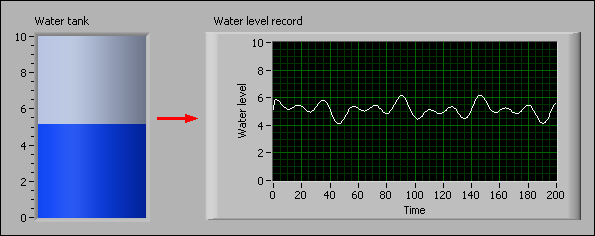Removing Offsets and Trends (System Identification Toolkit)
You can remove offsets and trends from the raw data set by using the SI Remove Trend VI. You can specify whether to remove offsets or trends by using the trend type input of this VI.
Refer to the Remove Trend VI in the labview\examples\System Identification\Getting Started\General.llb for an example that demonstrates how to remove the offset or trend from a signal.
 Open example
Open example
 Browse related examples
Browse related examples
Removing Offsets
An estimated system model is a linearized version of the plant around the operating point. You must subtract the operating points from the raw data samples because linearization is done with respect to the signal values relative to the operating point, which is the offset level of the signal.
The following figure shows an example of removing the offset level of a signal. The goal of the water tank is to keep the water level at six meters. The Water level record graph shows that the water level changes in the vicinity of the operating point of six meters. If you use the water level record for system identification, you must remove the six meter operating point value.

The SI Remove Trend VI enables you to remove the offset from the raw data set. You must set the trend type to mean to use this preprocessing technique.
Removing Trends
External influences might add some low frequency or periodic components to the data. These additional components are not relevant to the specific modeling problem. Examples of external influences include variations due to the 24-hour day cycle in power plants, seasonal influences in biological and economical systems, thermal expansion in rolling mills, 50 or 60 Hz interference in power lines, and so on. The amplitude of these trends can be large and can corrupt the results of signal analysis and parametric identification algorithms.
The SI Remove Trend VI provides a way for you to remove these external influences, or trends, from the raw data set. You must set the trend type to linear to use this preprocessing technique.